Numerical Simulation of Cooling Plate Using K-Epsilon Turbulence Model to Cool Down Large-Sized Graphite/LiFePO4 Battery at High C-Rates
Abstract
:1. Introduction
2. Testing Details
2.1. Laser Scanning
2.2. Experiments and Heat Flux Placement
2.3. Testing Procedure
3. Numerical Modeling
3.1. Governing Equations
3.2. Geometry and Boundary Conditions
3.2.1. Coolant Water
- (1)
- The stream is viewed as steady state, incompressible, and turbulent,
- (2)
- Water is picked as the flowing liquid,
- (3)
- Mass flow rate at each channel = 0.000277677 kg/s,
- (4)
- Total mass flow rate at all nine channels = 0.002499003 kg/s,
- (5)
- Area at each channel = 5.272 × 10−7 m2,
- (6)
- Density = 997.56 kg/m3,
- (7)
- Dynamic viscosity = 0.00088871 Pa-s,
- (8)
- The specific heat = 4181.72 J/kg-K,
- (9)
- Conductivity (thermal) = 0.62 W/m-K,
- (10)
- Turbulent Prandtl number = 0.9.
3.2.2. Outlet Cover-Aluminum
- (1)
- Specific heat = 903 J/kg-K,
- (2)
- Density = 2702 kg/m3,
- (3)
- Conductivity (thermal) = 237 W/m-K.
3.2.3. Volume Mesh Details (STAR CCM+)
- (1)
- Mesh type = polyhedral mesh and prism layer mesh,
- (2)
- Base size = 2 mm,
- (3)
- Number of prism layers = 2,
- (4)
- Thickness of prism layer = 0.3 mm,
- (5)
- Stretching of the prism layer = 1,
- (6)
- Growth factor for polyhedral mesh = 1.
3.2.4. Model Set-Up
- (1)
- Time: steady state,
- (2)
- Flow: turbulent,
- (3)
- Fluid: incompressible fluid,
- (4)
- Turbulence model: Realizable K-Epsilon (RANS),
- (5)
- Wall treatment: two-layer all y+ wall treatment (y+ ≈ 5),
- (6)
- Solver: segregated,
- (7)
- Convection: second-order,
- (8)
- Turbulence intensity: 0.01 (default),
- (9)
- Turbulent viscosity ratio: 10.0 (default).
3.3. Meshing in DEP MeshWorks 8.0
4. Analysis
4.1. Temperature Fields during 20 A
4.2. Temperature Fields during 40 A
4.3. Velocity Contours at 20 A and 40 A Releasing Currents
4.4. Transient Temperature Profiles of Water Flow and Voltage Distributions
5. Conclusions
- (i)
- The temperature fields inside the microchannel coolant plates increased as the discharge current increased between 20 A and 40 A;
- (ii)
- Incremental releasing currents resulted in increments in the heat flux at three assigned points on the LIB surface;
- (iii)
- The heat flux measuring devices nearest to the tabs provided higher values than the middle heat flux measuring devices. The coolant diagrams from the models were predictable with those received from testing;
- (iv)
- The simulated values obtained from STAR CCM+ were higher than the experimental values;
- (v)
- The velocity distribution was uniform for all cases, except at the inlet and outlet with curved flow paths with relatively higher velocity gradients.
Author Contributions
Funding
Institutional Review Board Statement
Informed Consent Statement
Data Availability Statement
Conflicts of Interest
Nomenclature
| model constants | |
| constant | |
| C | Potential or voltage [V] |
| generation of turbulence kinetic energy due to mean velocity gradients & buoyancy | |
| I | current [A] |
| turbulent kinetic energy (J) | |
| characteristic dimension (m) | |
| Prandtl number and Turbulent Prandtl number | |
| pressure (Pa) | |
| Re | Reynold’s number |
| user-defined source terms | |
| T | temperature [°C or K] |
| τ | time [s] |
| t | time [s] |
| u | speed (m/s) |
| mean fluid velocity (m/s) | |
| average velocity (m/s) | |
| turbulent eddy frequency (1/s) | |
| y+ | wall treatment |
| the contribution of the oscillating dilatation in compressible turbulence to the general dissipation rate | |
| density (kg/m3) | |
| gradient operator | |
| dynamic fluid viscosity (Ns/m2) | |
| Reynold’s stress | |
| kinematic fluid viscosity (m2/s) | |
| turbulent Prandtl numbers for and | |
| sim | simulated |
| act | actual |
| + | Related to wall treatment |
| ° | degree |
| Ah | Ampere-hour |
| ANSYS Inc. | American Computer-aided engineering software developer |
| BTMS | Battery thermal management system |
| C | Capacity |
| CC | Constant-current |
| CV | Constant-voltage |
| CT | Computed tomography |
| CAD | Computer aided design |
| CFD | Computational fluid dynamics |
| DEP | Detroit Engineered Products, Inc. |
| CPU | Computer user memory |
| EV or BEV | Electric vehicle or battery-operated electric vehicle |
| FEM | Finite element method |
| FCV | Fuel cell vehicle |
| FSP | Field synergy principle |
| HEV | Hybrid electric vehicle |
| K.E. | Kinetic energy |
| LiMn2O4 | Lithium manganese oxide |
| LiMnNiCOO2 | Lithium manganese cobalt oxide |
| LiFePO4 | Lithium iron phosphate |
| LIB | Lithium-ion batteries |
| LES | Large eddy simulation |
| LED | Light-emitting diode |
| MeshWorks | Software used for mesh generation and CAD |
| PC | Personal computer |
| PCM | Phase change material |
| PHEV | Plug-In hybrid electric vehicle |
| RE | Reverse engineering |
| RNG | Renormalization group |
| RSM | Reynold’s stress model |
| RANS | Reynolds-averaged Navier-Stokes |
| SST | Shear stress transport |
| SLPB | Superior lithium polymer battery |
| STAR CCM+ | Simulation of Turbulent flow in Arbitary Regions-Computational Continuum Mechanics + (C++ based) |
| US06 | United States 06 drive cycle |
| 2D | Two-dimensional |
| 3D | Three-dimensional |
| 18650 | IFR 18650 cylindrical battery (“I” is for Lithium-ion rechargeable, “F” is for the component “Fe” that is Iron, “R” is for the round cell, 18650 means diameter of 1.8 cm and 650 means the height is 6.5 cm) |
References
- Wang, Q.; Sun, Q.; Ping, P.; Zhao, X.; Sun, J.; Lin, Z. Heat transfer in the dynamic cycling of lithium–titanate batteries. Int. J. Heat Mass Transf. 2016, 93, 896–905. [Google Scholar] [CrossRef]
- Tran, M.-K.; Akinsanya, M.; Panchal, S.; Fraser, R.; Fowler, M. Design of a Hybrid Electric Vehicle Powertrain for Performance Optimization Considering Various Powertrain Components and Configurations. Vehicles 2021, 3, 20–32. [Google Scholar] [CrossRef]
- Ritchie, A.; Howard, W. Recent developments and likely advances in lithium-ion batteries. J. Power Sources 2006, 162, 809–812. [Google Scholar] [CrossRef]
- Ye, Y.; Saw, L.H.; Shi, Y.; Tay, A.A. Numerical analyses on optimizing a heat pipe thermal management system for lithium-ion batteries during fast charging. Appl. Therm. Eng. 2015, 86, 281–291. [Google Scholar] [CrossRef]
- Tran, M.-K.; Fowler, M. A Review of Lithium-Ion Battery Fault Diagnostic Algorithms: Current Progress and Future Challenges. Algorithms 2020, 13, 62. [Google Scholar] [CrossRef] [Green Version]
- Tran, M.-K.; Mevawalla, A.; Aziz, A.; Panchal, S.; Xie, Y.; Fowler, M. A Review of Lithium-Ion Battery Thermal Runaway Modeling and Diagnosis Approaches. Processes 2022, 10, 1192. [Google Scholar] [CrossRef]
- Tran, M.-K.; Mathew, M.; Janhunen, S.; Panchal, S.; Raahemifar, K.; Fraser, R.; Fowler, M. A comprehensive equivalent circuit model for lithium-ion batteries, incorporating the effects of state of health, state of charge, and temperature on model parameters. J. Energy Storage 2021, 43, 103252. [Google Scholar] [CrossRef]
- Tran, M.-K.; Bhatti, A.; Vrolyk, R.; Wong, D.; Panchal, S.; Fowler, M.; Fraser, R. A Review of Range Extenders in Battery Electric Vehicles: Current Progress and Future Perspectives. WEVJ 2021, 12, 54. [Google Scholar] [CrossRef]
- Tran, M.-K.; DaCosta, A.; Mevawalla, A.; Panchal, S.; Fowler, M. Comparative Study of Equivalent Circuit Models Performance in Four Common Lithium-Ion Batteries: LFP, NMC, LMO, NCA. Batteries 2021, 7, 51. [Google Scholar] [CrossRef]
- Panchal, S.; Mathewson, S.; Fraser, R.; Culham, R.; Fowler, M. Thermal Management of Lithium-Ion Pouch Cell with Indirect Liquid Cooling Using Dual Cold Plates Approach. SAE Int. 2015, 4, 1–15. [Google Scholar] [CrossRef]
- Tran, M.-K.; Cunanan, C.; Panchal, S.; Fraser, R.; Fowler, M. Investigation of Individual Cells Replacement Concept in Lithium-Ion Battery Packs with Analysis on Economic Feasibility and Pack Design Requirements. Processes 2021, 9, 2263. [Google Scholar] [CrossRef]
- Tran, M.-K.; Panchal, S.; Khang, T.D.; Panchal, K.; Fraser, R.; Fowler, M. Concept Review of a Cloud-Based Smart Battery Management System for Lithium-Ion Batteries: Feasibility, Logistics, and Functionality. Batteries 2022, 8, 19. [Google Scholar] [CrossRef]
- Wang, C.H.; Lin, T.; Huang, J.T.; Rao, Z.H. Temperature response of a high power lithium-ion battery subjected to high current discharge. Mater. Res. Innov. 2015, 19, S2-156. [Google Scholar] [CrossRef]
- Panchal, S.; Dincer, I.; Agelin-Chaab, M.; Fowler, M.; Fraser, R. Uneven temperature and voltage distributions due to rapid discharge rates and different boundary conditions for series-connected LiFePO 4 batteries. Int. Commun. Heat Mass Transf. 2017, 81, 210–217. [Google Scholar] [CrossRef]
- Teng, H.; Ma, Y.; Yeow, K.; Thelliez, M. An Analysis of a Lithium-ion Battery System with Indirect Air Cooling and Warm-Up. SAE Int. J. Passeng. Cars—Mech. Syst. 2011, 4, 1343–1357. [Google Scholar] [CrossRef]
- He, F.; Ma, L. Thermal Management in Hybrid Power Systems Using Cylindrical and Prismatic Battery Cells. Heat Transf. Eng. 2015, 37, 581–590. [Google Scholar] [CrossRef]
- Giuliano, M.R.; Prasad, A.K.; Advani, S.G. Experimental study of an air-cooled thermal management system for high capacity lithium–titanate batteries. J. Power Sources 2012, 216, 345–352. [Google Scholar] [CrossRef]
- Jin, L.; Lee, P.; Kong, X.; Fan, Y.; Chou, S. Ultra-thin minichannel LCP for EV battery thermal management. Appl. Energy 2013, 113, 1786–1794. [Google Scholar] [CrossRef]
- Lin, C.; Xu, S.; Chang, G.; Liu, J. Experiment and simulation of a LiFePO4 battery pack with a passive thermal management system using composite phase change material and graphite sheets. J. Power Sources 2015, 275, 742–749. [Google Scholar] [CrossRef]
- Wang, Q.; Jiang, B.; Li, B.; Yan, Y. A critical review of thermal management models and solutions of lithiumion batteries for the development of pure electric vehicles. Renew. Sustain. Energy Rev. 2016, 64, 106–128. [Google Scholar] [CrossRef]
- Koca, F.; Zabun, M. The effect of outlet location on heat transfer performance in micro pinfin cooling used for a CPU. Eur. Phys. J. Plus 2021, 136, 1–15. [Google Scholar] [CrossRef]
- Zhao, Y.; Akolekar, H.D.; Weatheritt, J.; Michelassi, V.; Sandberg, R.D. RANS turbulence model development using CFD-driven machine learning. J. Comput. Phys. 2020, 411, 109413. [Google Scholar] [CrossRef] [Green Version]
- Vyroubal, P.; Kazda, T.; Maxa, J.; Vondrák, J. Analysis of Temperature Field in Lithium Ion Battery by Discharging. ECS Trans. 2015, 70, 269–273. [Google Scholar] [CrossRef]
- Yeow, K.; Teng, H.; Thelliez, M.; Tan, E. Thermal Analysis of a Li-ion Battery System with Indirect Liquid Cooling Using Finite Element Analysis Approach. SAE Int. J. Altern. Powertrains 2012, 1, 65–78. [Google Scholar] [CrossRef]
- Jarrett, A.; Kim, I.Y. Design optimization of electric vehicle battery cooling plates for thermal performance. J. Power Sources 2011, 196, 10359–10368. [Google Scholar] [CrossRef]
- Deng, T.; Zhang, G.; Ran, Y. Study on thermal management of rectangular Li-ion battery with serpentine-channel cold plate. Int. J. Heat Mass Transf. 2018, 125, 143–152. [Google Scholar] [CrossRef]
- Mondal, B.; Lopez, C.F.; Verma, A.; Mukherjee, P.P. Vortex generators for active thermal management in lithium-ion battery systems. Int. J. Heat Mass Transf. 2018, 124, 800–815. [Google Scholar] [CrossRef]
- De Vita, A.; Maheshwari, A.; Destro, M.; Santarelli, M.; Carello, M. Transient thermal analysis of a lithium-ion battery pack comparing different cooling solutions for automotive applications. Appl. Energy 2017, 206, 101–112. [Google Scholar] [CrossRef]
- Cooper, S.; Eastwood, D.; Gelb, J.; Damblanc, G.; Brett, D.; Bradley, R.; Withers, P.; Lee, P.; Marquis, A.; Brandon, N.; et al. Image based modelling of microstructural heterogeneity in LiFePO 4 electrodes for Li-ion batteries. J. Power Sources 2013, 247, 1033–1039. [Google Scholar] [CrossRef]
- Basu, S.; Hariharan, K.S.; Kolake, S.M.; Song, T.; Sohn, D.K.; Yeo, T. Coupled electrochemical thermal modelling of a novel Li-ion battery pack thermal management system. Appl. Energy 2016, 181, 1–13. [Google Scholar] [CrossRef]
- Mohammadian, S.; He, Y.L.; Zhang, Y. Internal cooling of a lithium-ion battery using electrolyte as coolant through microchannels embedded inside the electrodes. J. Power Sources 2015, 293, 458–466. [Google Scholar] [CrossRef]
- Al-Zareer, M.; Dincer, I.; Rosen, M.A. Heat transfer modeling of a novel battery thermal management system. Numer. Heat Transf. Part A Appl. 2018, 73, 277–290. [Google Scholar] [CrossRef]
- Li, X.; He, F.; Ma, L. Thermal management of cylindrical batteries investigated using wind tunnel testing and computational fluid dynamics simulation. J. Power Sources 2013, 238, 395–402. [Google Scholar] [CrossRef]
- Jassem, R.R.; Salem, T.K. An Experimental and Numerical Study the Performance of Finned liquid Cold-Plate with Different Operating Conditions. Int. J. Recent Res. Rev. 2016, 9, 2277–2283. [Google Scholar]
- Jiaqiang, E.; Xu, S.; Deng, Y.; Zhu, H.; Zuo, W.; Wang, H.; Chen, J.; Peng, Q.; Zhang, Z. Investigation on thermal performance and pressure loss of the fluid cold-plate used in thermal management system of the battery pack. Appl. Therm. Eng. 2018, 145, 552–568. [Google Scholar] [CrossRef]
- Panchal, S.; Khasow, R.; Dincer, I.; Agelin-Chaab, M.; Fraser, R.; Fowler, M. Numerical modeling and experimental investigation of a prismatic battery subjected to water cooling. Numer. Heat Transf. Part A Appl. 2017, 71, 626–637. [Google Scholar] [CrossRef]
- Panchal, S.; Gudlanarva, K.; Tran, M.-K.; Fraser, R.; Fowler, M. High Reynold’s Number Turbulent Model for Micro-Channel Cold Plate Using Reverse Engineering Approach for Water-Cooled Battery in Electric Vehicles. Energies 2020, 13, 1638. [Google Scholar] [CrossRef] [Green Version]
- Panchal, S.; Dincer, I.; Agelin-Chaab, M.; Fraser, R.; Fowler, M. Design and simulation of a lithium-ion battery at large C-rates and varying boundary conditions through heat flux distributions. Measurement 2017, 116, 382–390. [Google Scholar] [CrossRef] [Green Version]
- ANSYS, Inc. ANSYS Fluent Advanced Add-On Modules. Available online: http://www.ansys.com (accessed on 1 October 2020).
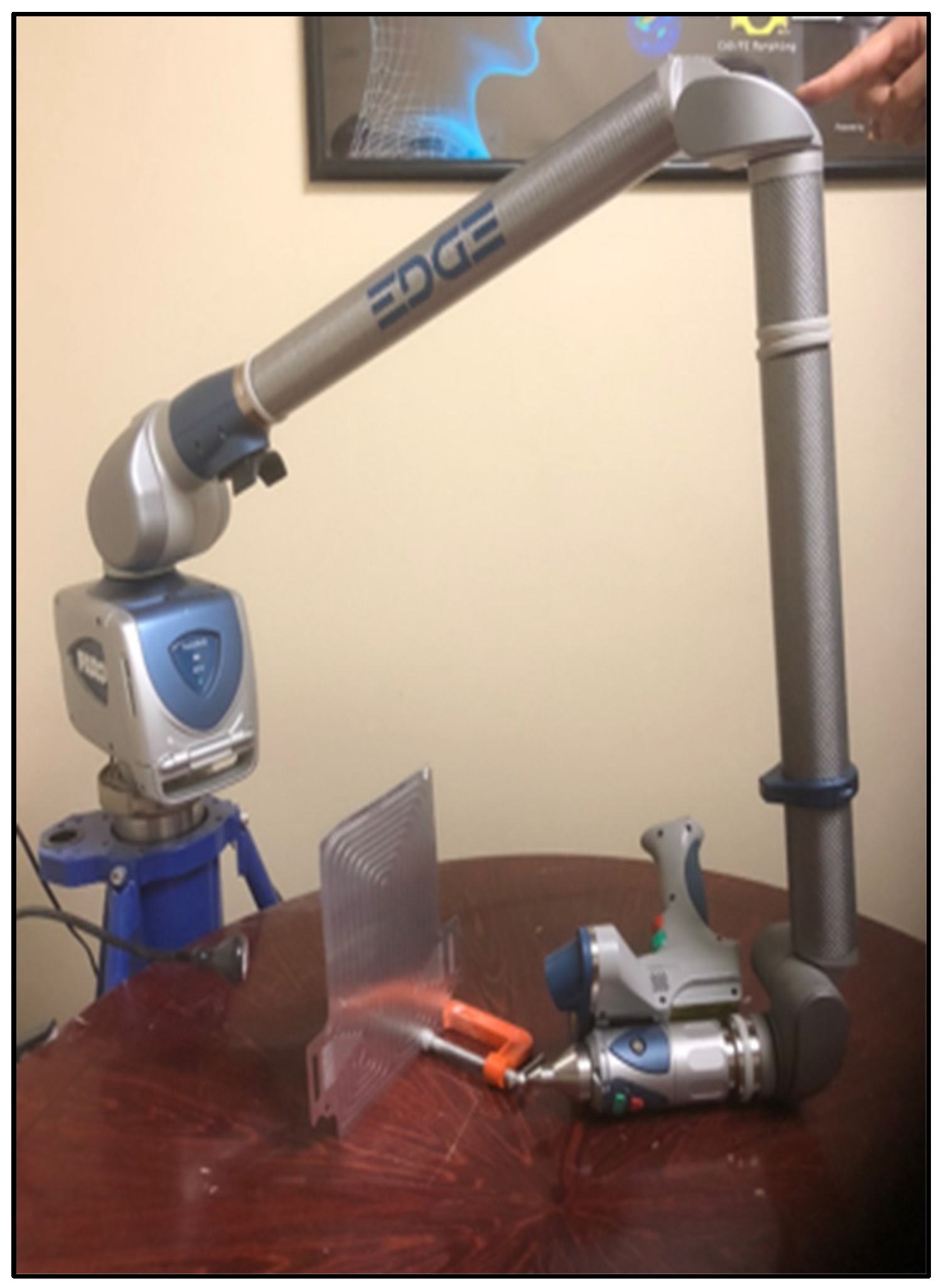
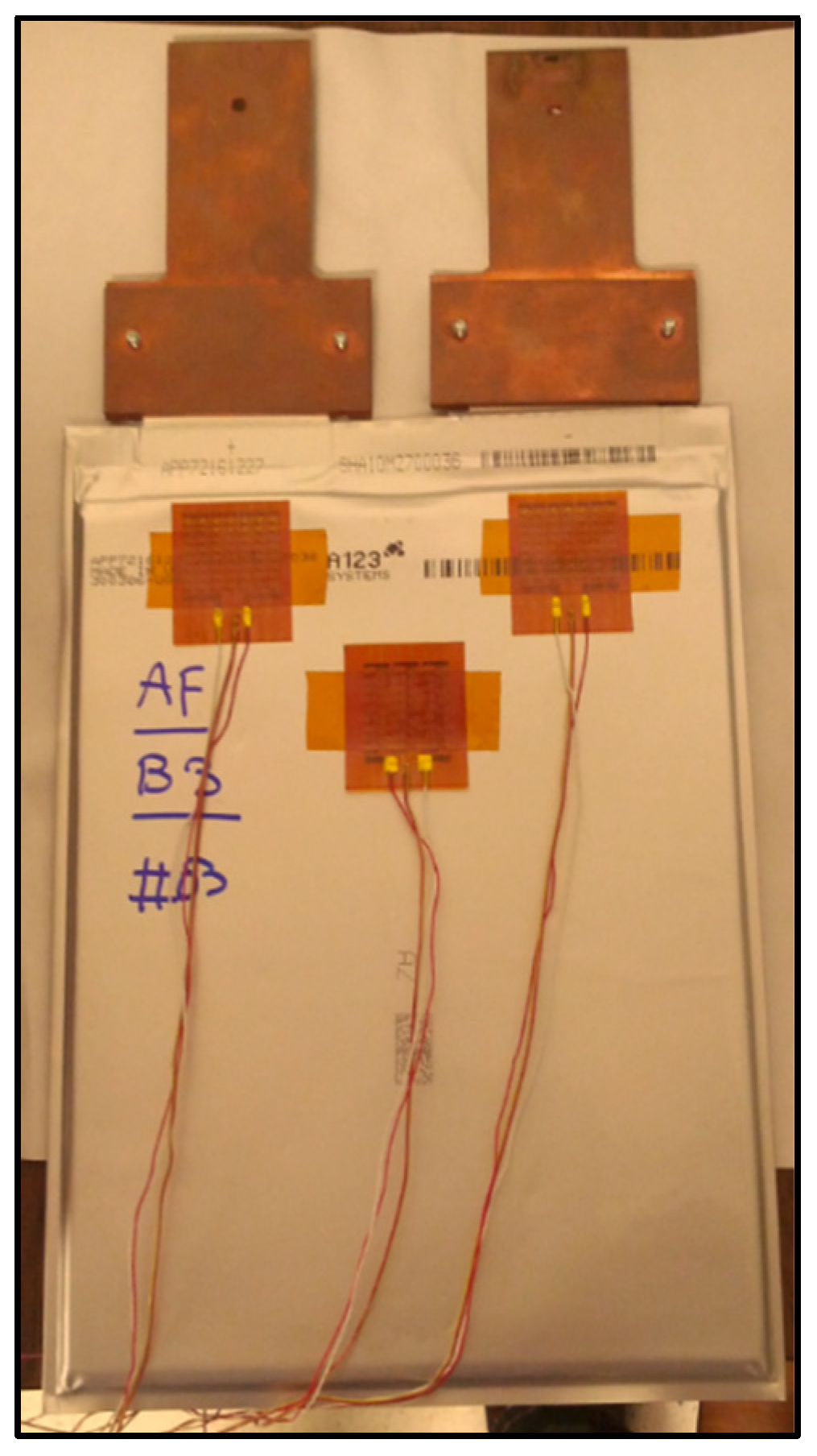
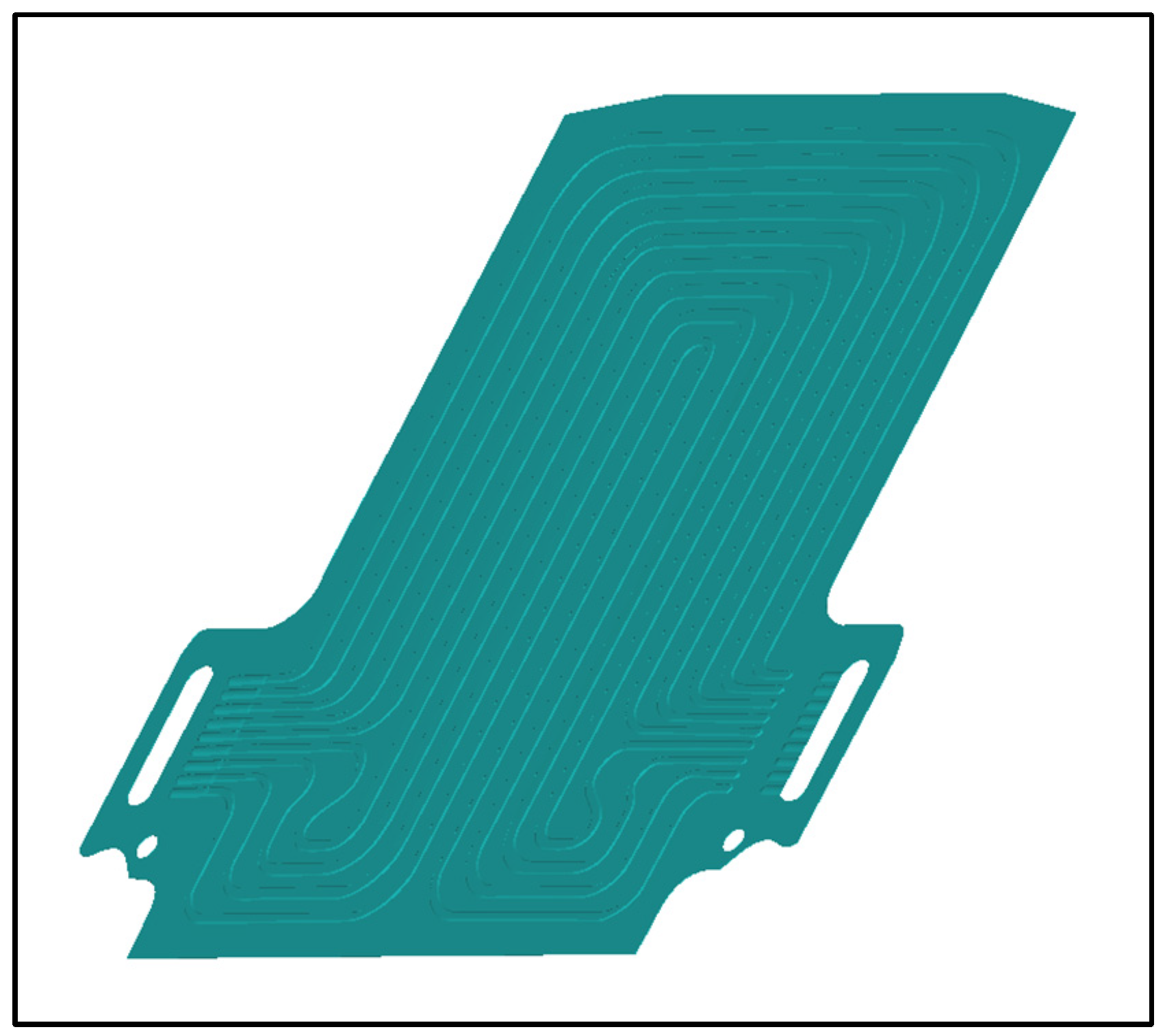
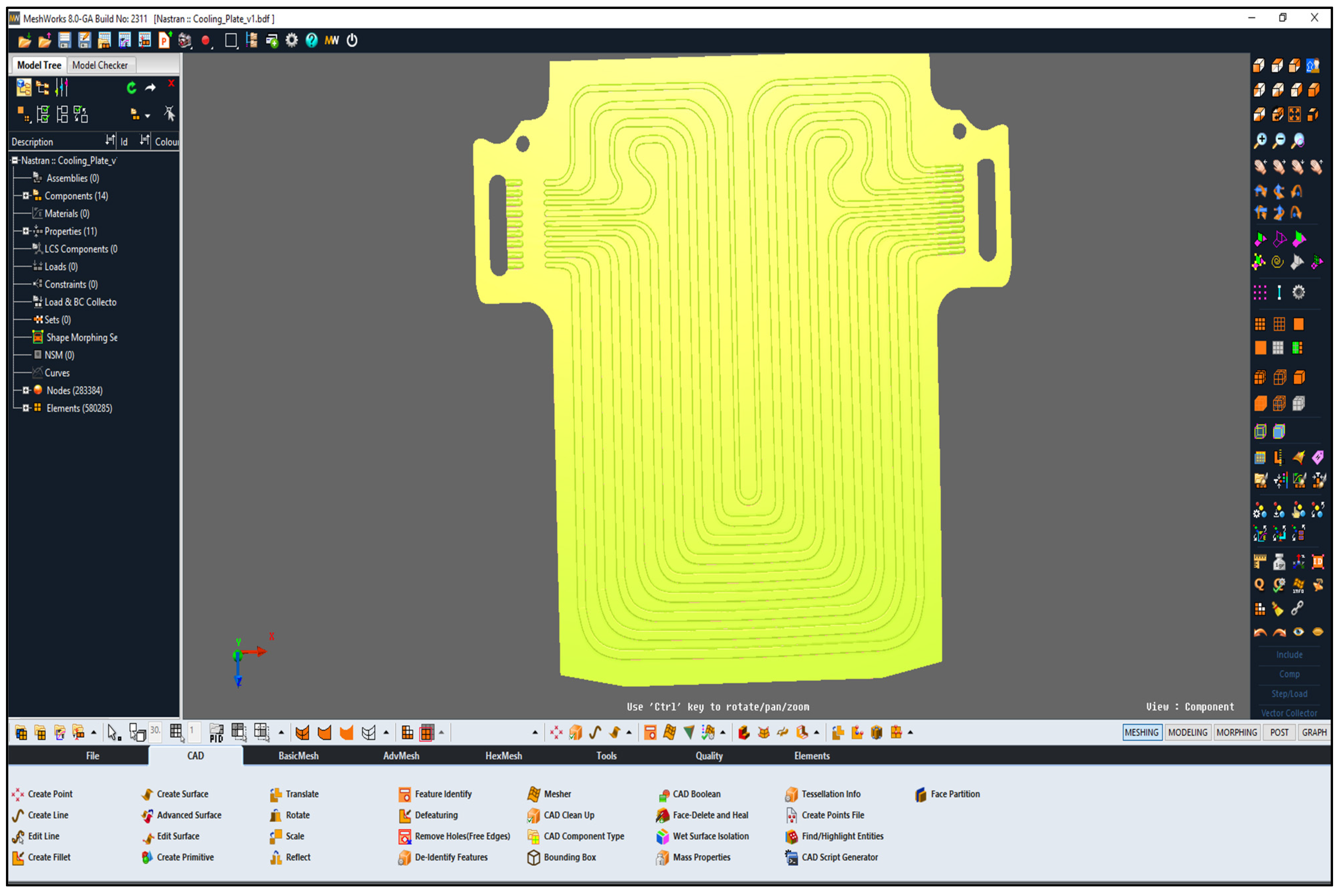

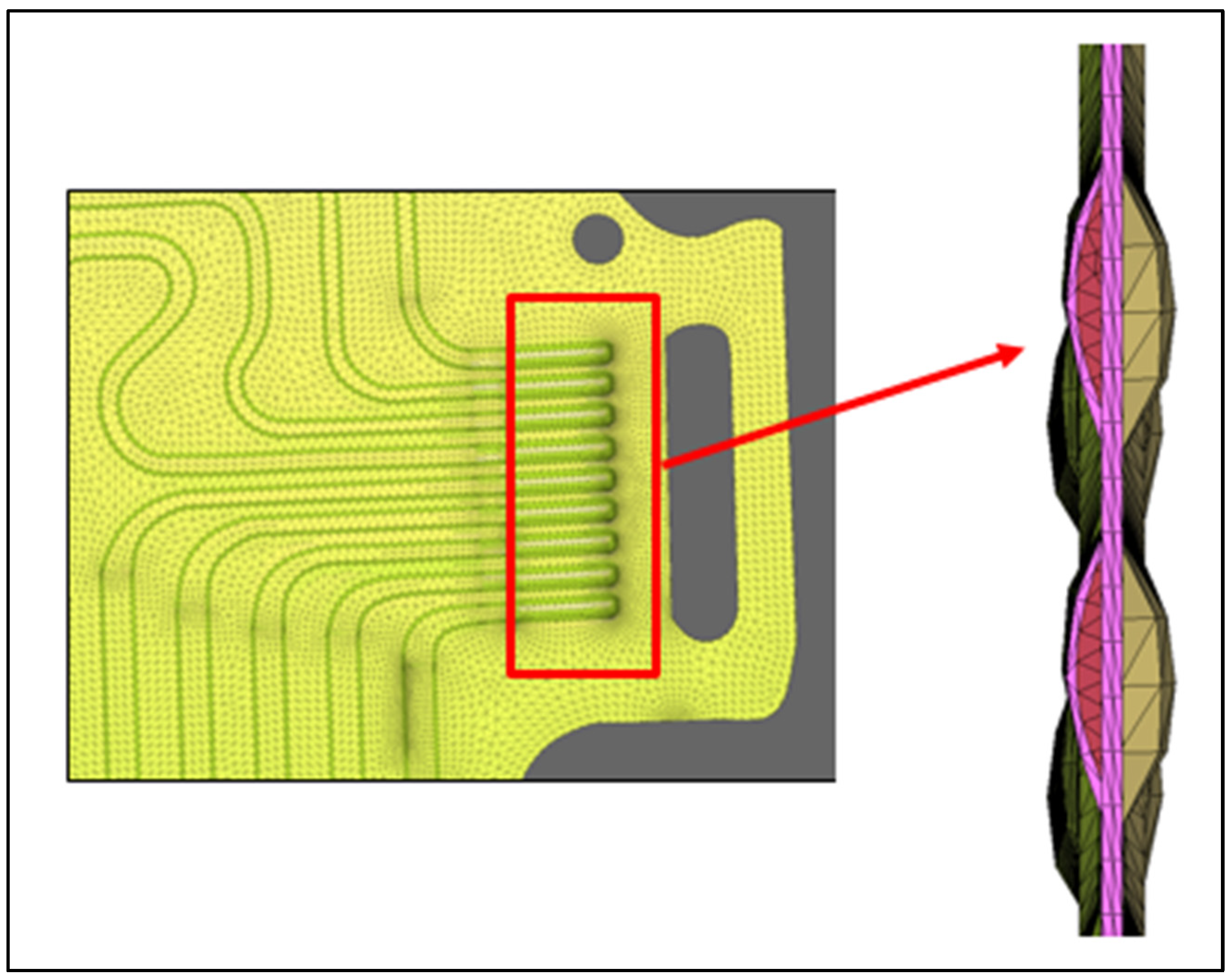

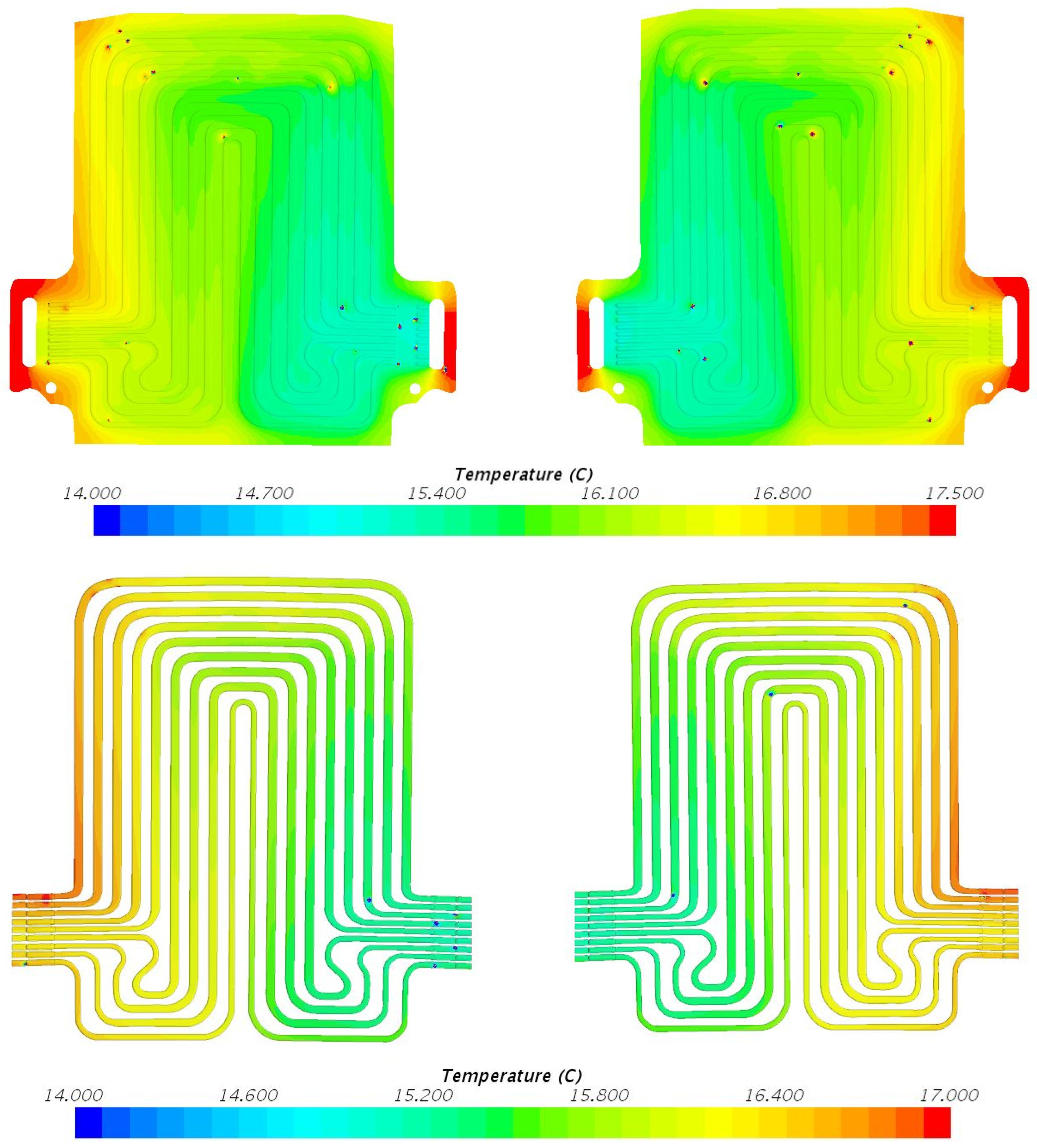
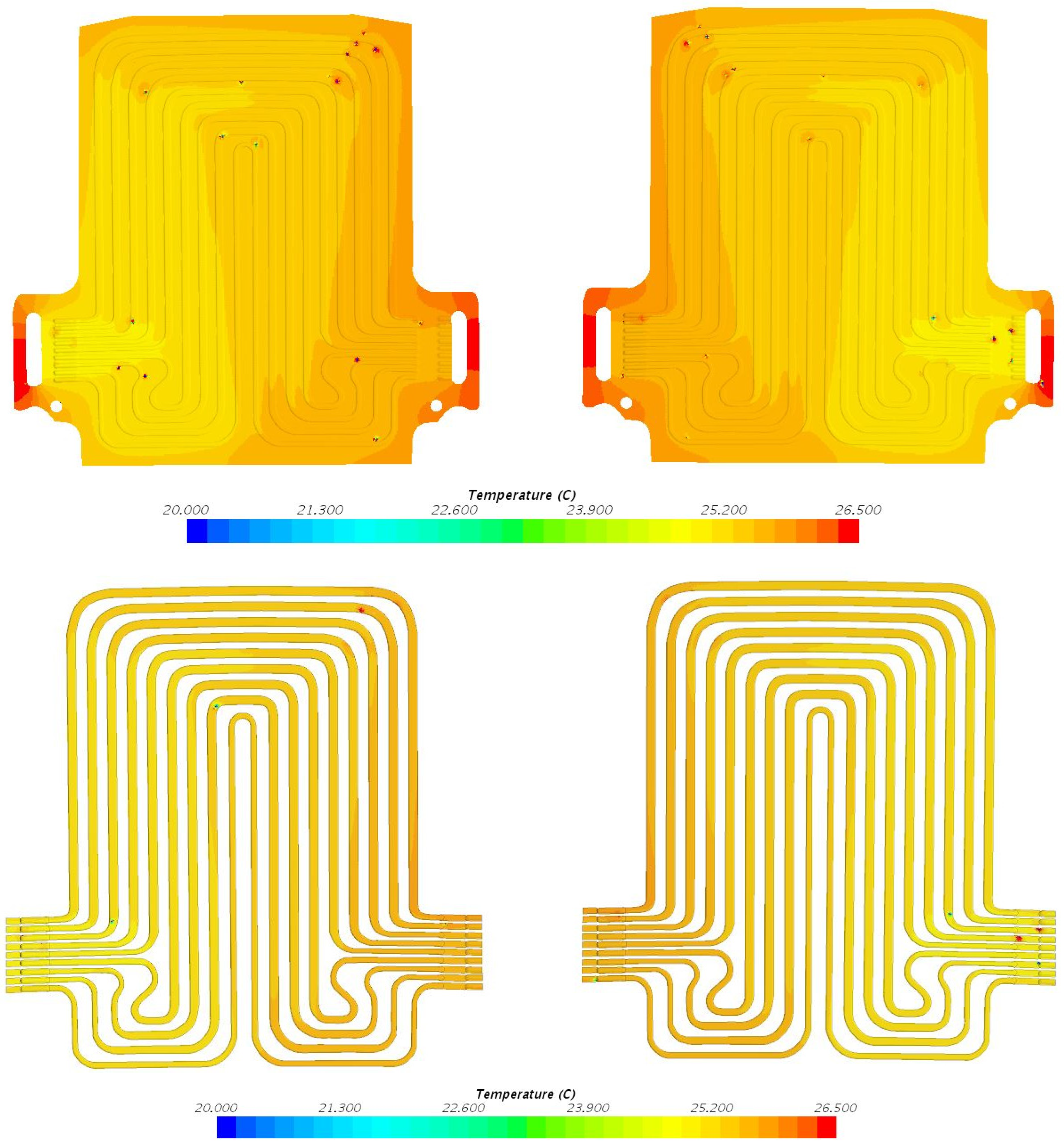
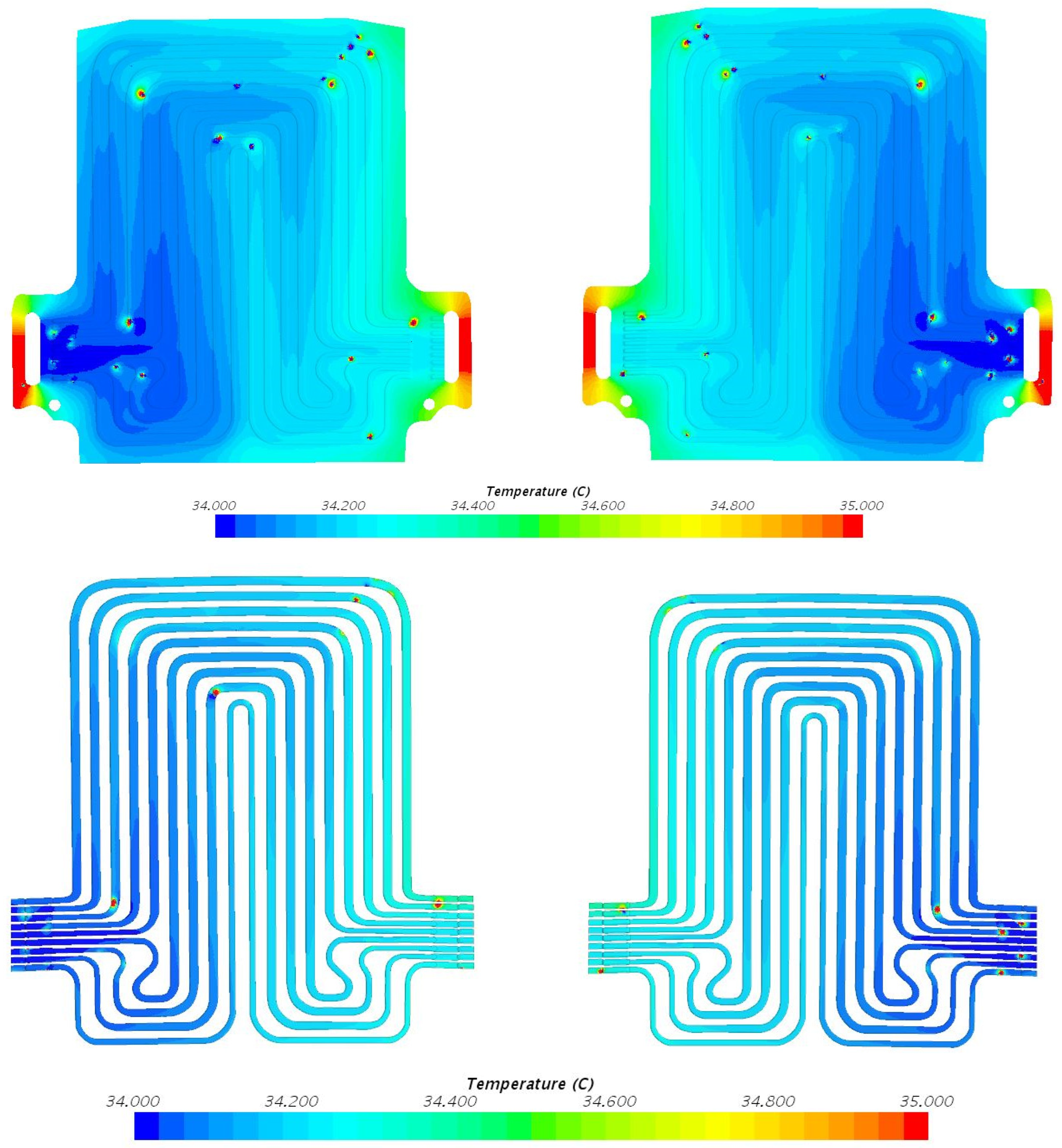
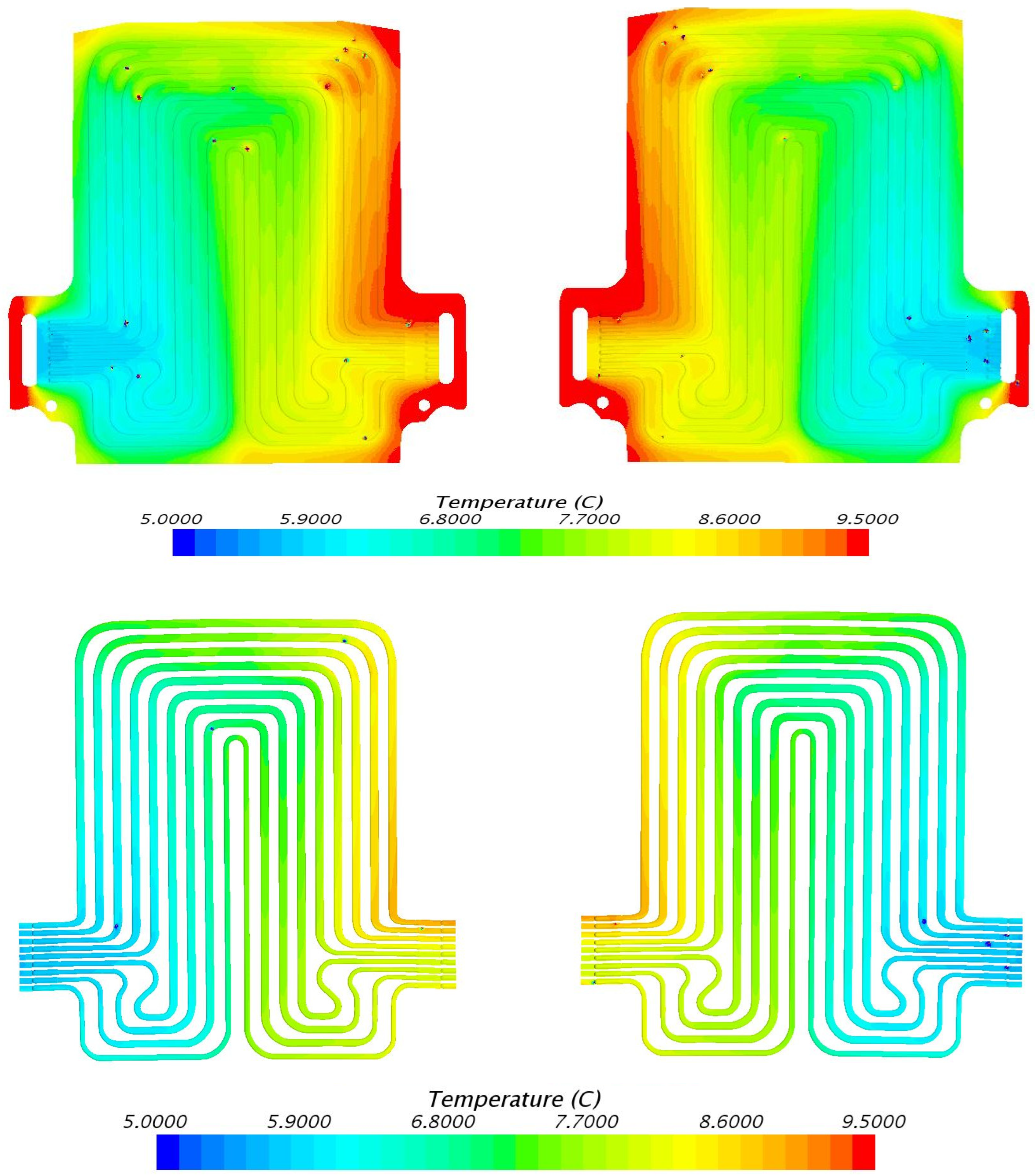
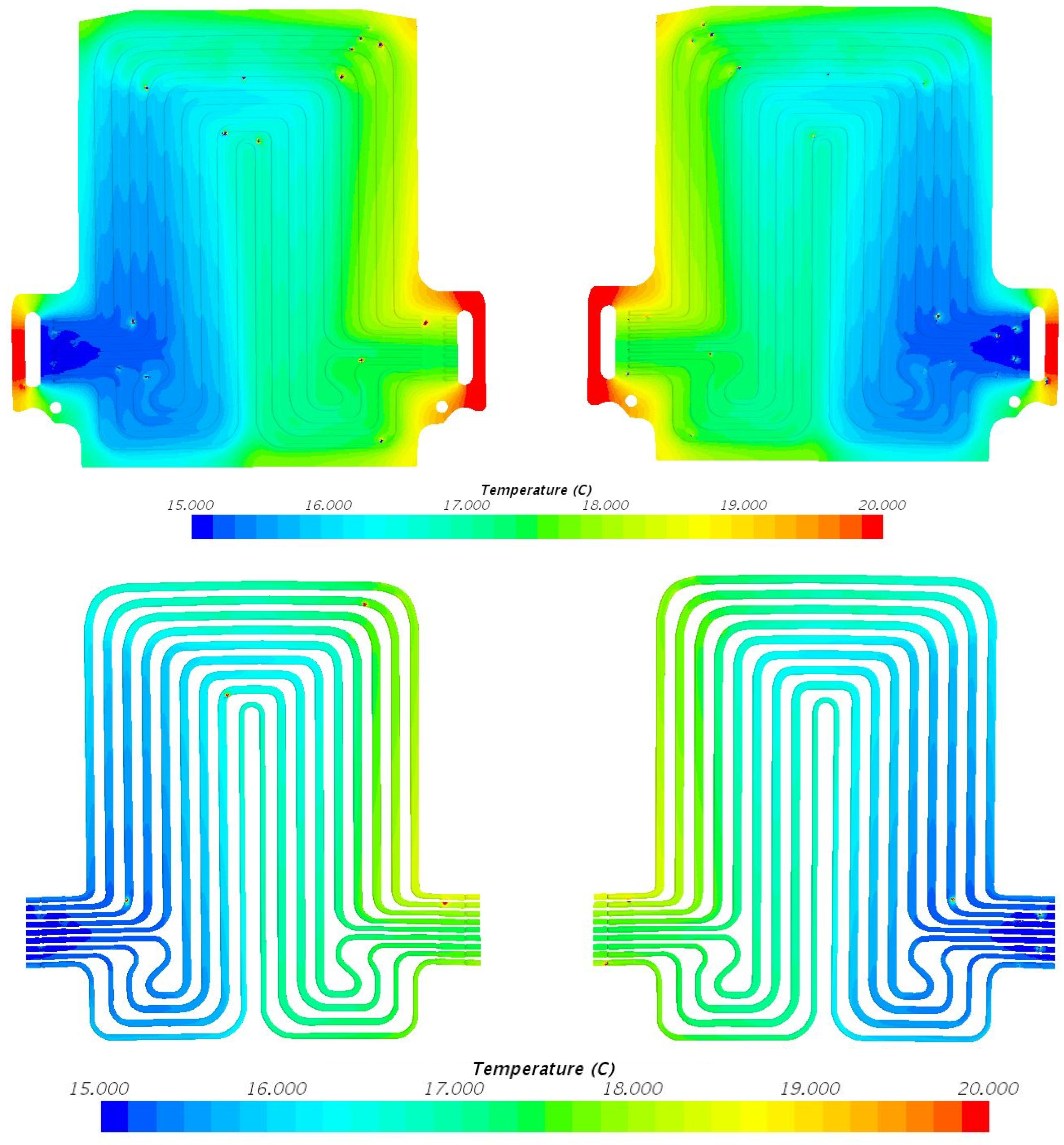

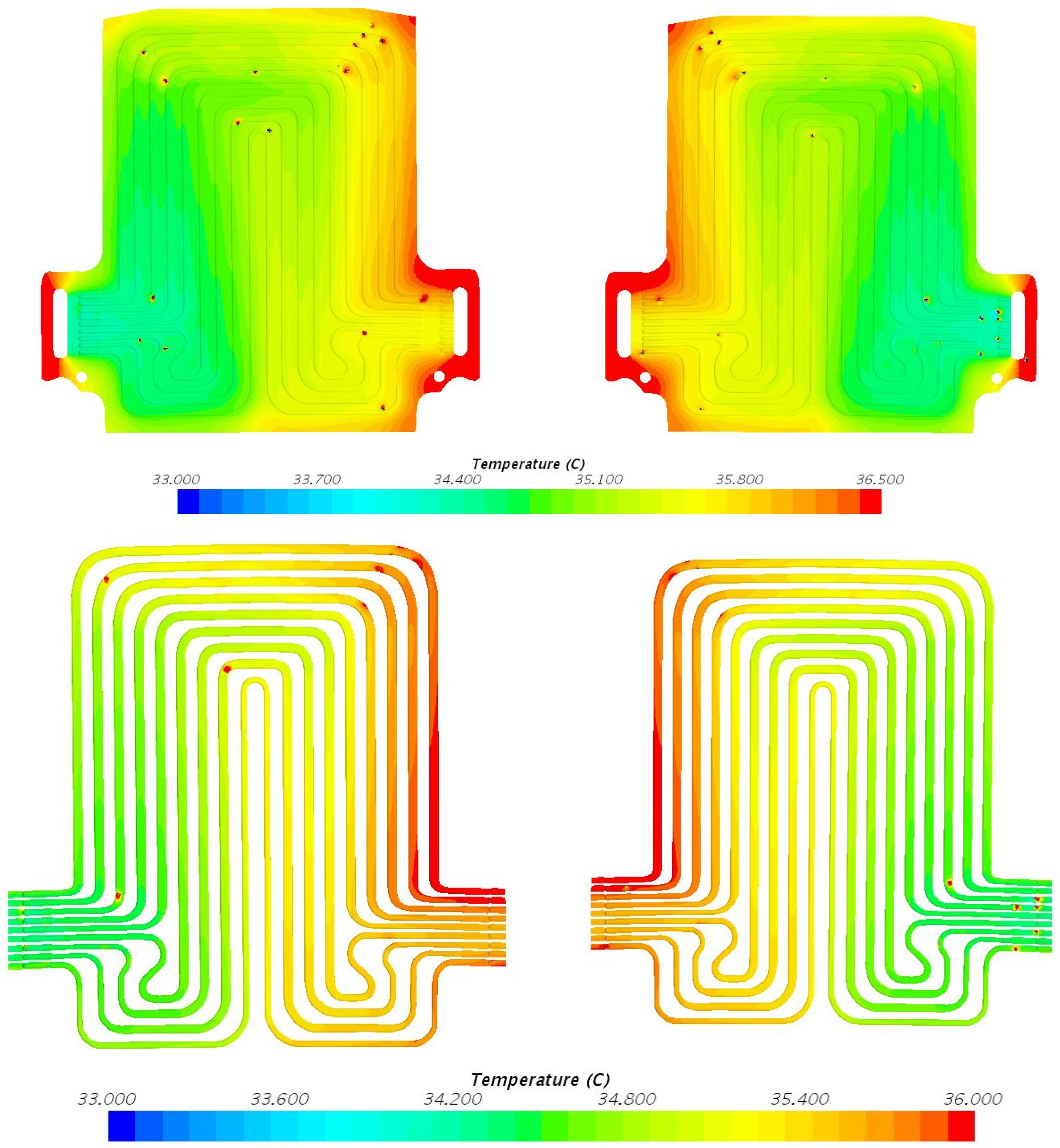
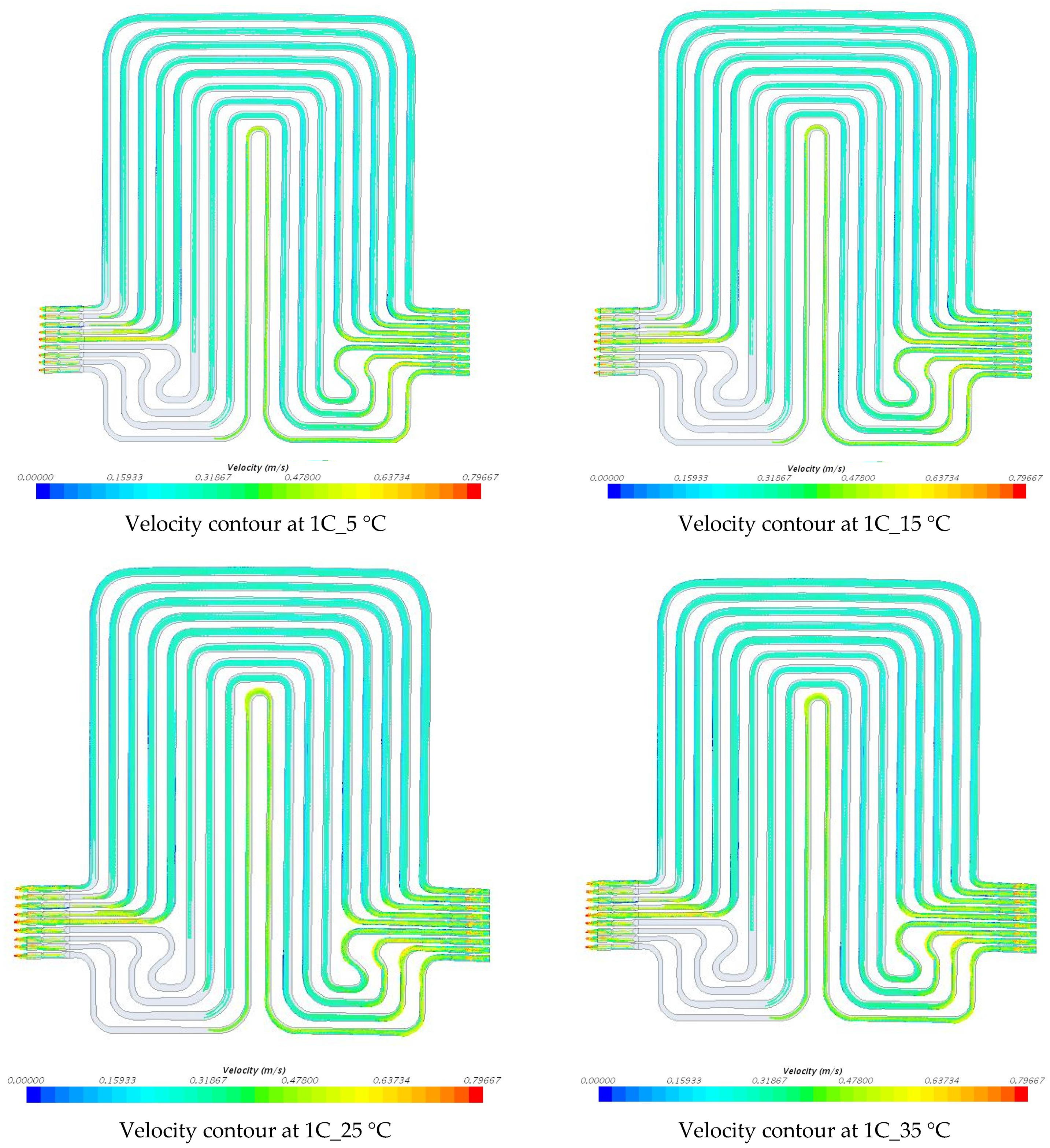
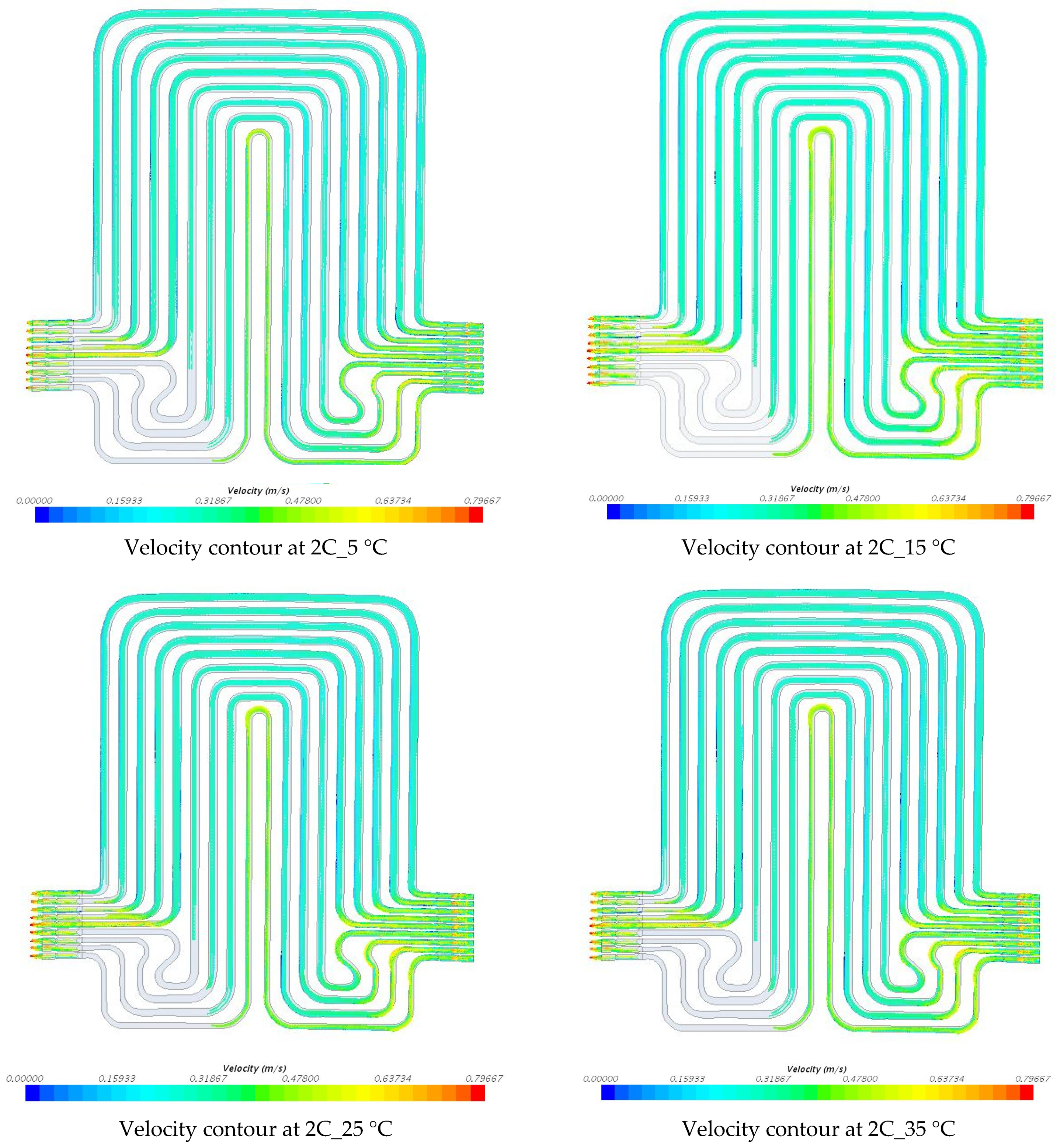
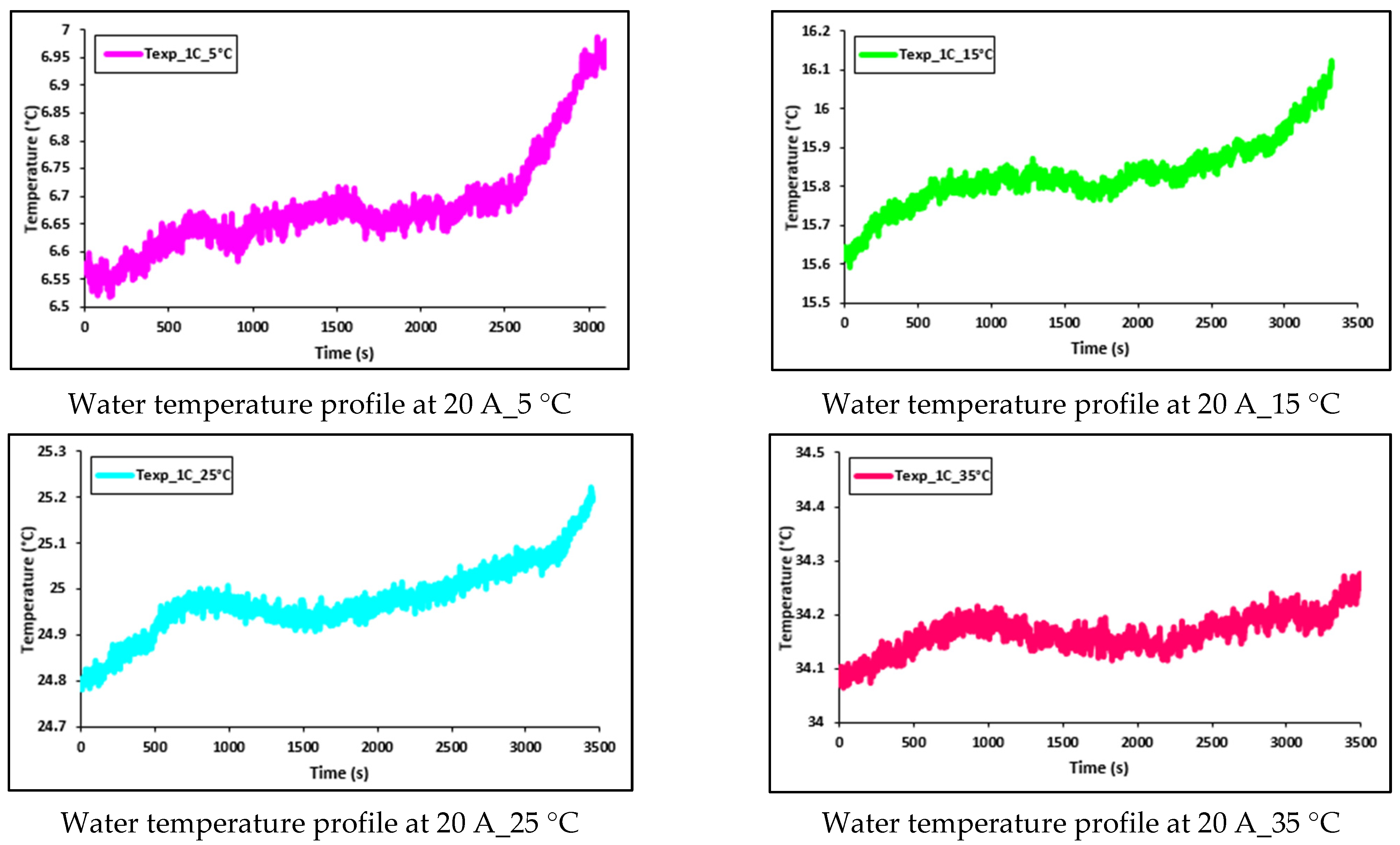


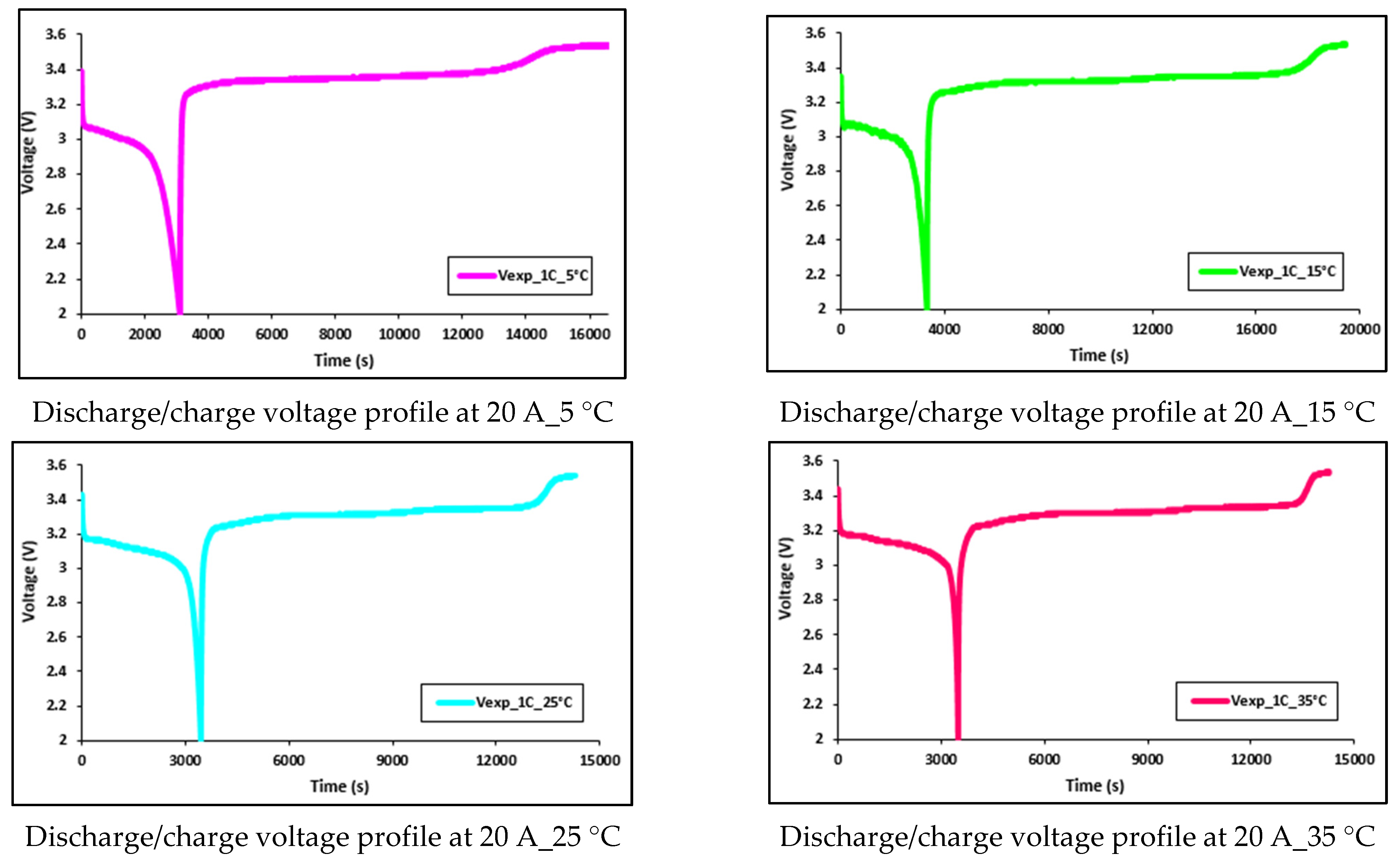


| Specification | Value | Unit |
|---|---|---|
| Material of Electrolyte | Carbonate based | - |
| Material of Anode | Graphite | - |
| Material of Cathode | LiFePO4 | - |
| Voltage (nominal) of the cell | 3.3 | V |
| Energy (nominal) of the cell | 65 | Wh |
| Capacity (nominal) of the cell | 20 | Ah |
| Mass of the battery cell | 496 | g |
| Dimensions of the cell | h = 227, w = 160, t = 7.25 | mm |
| Energy density of the cell | 247 | Wh/L |
| Temperature range (operating) | −30 to 55 | °C |
| Specific power | 2400 | W/kg |
| Storage temperature range | −40 to 60 | °C |
| Discharge power | 1200 | W |
| Specific energy | 131 | Wh/kg |
| Internal resistance | 0.5 | mΩ |
| Maximum discharge | 300 | A |
| Number of cycles | Minimum 300, approximately 2000 | Cycles |
| Volume of the cell | 0.263 | L |
| Maximum charge | 300 | A |
| Cooling Fluid | Operating Temperature [°C] | Discharge Current |
|---|---|---|
| Water | 5 | 20 A, 40 A |
| 15 | 20 A, 40 A | |
| 25 | 20 A, 40 A | |
| 35 | 20 A, 40 A |
| Working Fluid | Operating Temperature [°C] | Difference between Experimental and Simulated Values | Inlet and Outlet Temperature [°C] | |||
|---|---|---|---|---|---|---|
| 20 A (1C) | 40 A (2C) | |||||
| Inlet | Outlet | Inlet | Outlet | |||
| Water | 5 | Exp. | 5.283 | 6.57 | 5.662 | 7.58 |
| Sim. | 6.5726 | 6.51 | 7.581 | 8.25 | ||
| Difference | 1.2896 | −0.06 | 1.919 | 0.67 | ||
| 15 | Exp. | 15.1678 | 16.10 | 15.0313 | 16.24 | |
| Sim. | 16.1043 | 16.45 | 16.2379 | 17.69 | ||
| Difference | 0.9365 | 0.35 | 1.2066 | 1.45 | ||
| 25 | Exp. | 25.0137 | 25.21 | 25.0999 | 25.60 | |
| Sim. | 25.2065 | 25.59 | 25.6036 | 26.67 | ||
| Difference | 0.1928 | 0.38 | 0.5037 | 1.07 | ||
| 35 | Exp. | 34.012 | 34.72 | 34.356 | 34.77 | |
| Sim. | 34.7207 | 34.26 | 34.766 | 35.72 | ||
| Difference | 0.7087 | −0.46 | 0.41 | 0.95 | ||
Publisher’s Note: MDPI stays neutral with regard to jurisdictional claims in published maps and institutional affiliations. |
© 2022 by the authors. Licensee MDPI, Basel, Switzerland. This article is an open access article distributed under the terms and conditions of the Creative Commons Attribution (CC BY) license (https://creativecommons.org/licenses/by/4.0/).
Share and Cite
Panchal, S.; Gudlanarva, K.; Tran, M.-K.; Herdem, M.S.; Panchal, K.; Fraser, R.; Fowler, M. Numerical Simulation of Cooling Plate Using K-Epsilon Turbulence Model to Cool Down Large-Sized Graphite/LiFePO4 Battery at High C-Rates. World Electr. Veh. J. 2022, 13, 138. https://doi.org/10.3390/wevj13080138
Panchal S, Gudlanarva K, Tran M-K, Herdem MS, Panchal K, Fraser R, Fowler M. Numerical Simulation of Cooling Plate Using K-Epsilon Turbulence Model to Cool Down Large-Sized Graphite/LiFePO4 Battery at High C-Rates. World Electric Vehicle Journal. 2022; 13(8):138. https://doi.org/10.3390/wevj13080138
Chicago/Turabian StylePanchal, Satyam, Krishna Gudlanarva, Manh-Kien Tran, Münür Sacit Herdem, Kirti Panchal, Roydon Fraser, and Michael Fowler. 2022. "Numerical Simulation of Cooling Plate Using K-Epsilon Turbulence Model to Cool Down Large-Sized Graphite/LiFePO4 Battery at High C-Rates" World Electric Vehicle Journal 13, no. 8: 138. https://doi.org/10.3390/wevj13080138
APA StylePanchal, S., Gudlanarva, K., Tran, M.-K., Herdem, M. S., Panchal, K., Fraser, R., & Fowler, M. (2022). Numerical Simulation of Cooling Plate Using K-Epsilon Turbulence Model to Cool Down Large-Sized Graphite/LiFePO4 Battery at High C-Rates. World Electric Vehicle Journal, 13(8), 138. https://doi.org/10.3390/wevj13080138









